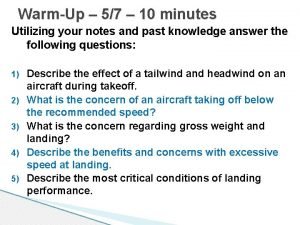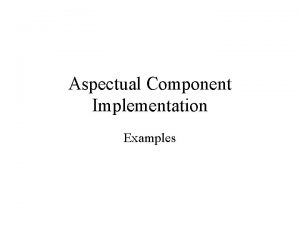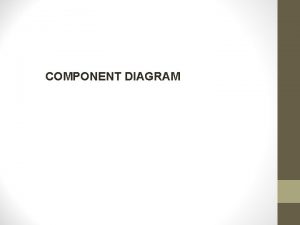Adaptation communication as an adaptation component of an









- Slides: 9

Adaptation communication as an adaptation component of an NDC: guidelines and considerations Bonn, Germany Wednesday 21 October 2020 UNFCCC secretariat, Adaptation Division

KEY MESSAGES • Under the Paris Agreement and Katowice decisions, adaptation components of NDCs are considered part of adaptation communications. Decision 9/CMA. 1 (guidance for adaptation communications) provides the guidance for adaptation components of NDCs. • 9/CMA. 1 outlines the purpose, process, linkages, and possible sources of support relevant to adaptation communications, including as adaptation component of NDCs. It also identifies nine types of information to include and encourages inclusion of forward-looking information. • To reduce duplications and additional burdens, Parties can build their adaptation communication on the information generated during the process to formulate and implement NAPs consistent with the role the NAP as the planning instrument, and of the adaptation communication as a communication instrument.

ADAPTATION COMMUNICATIONS AND ADAPTATION COMPONENTS OF NDCS IN THE PARIS AGREEMENT AND KATOWICE DECISIONS • Art. 7. 10: each Party should submit an adaptation communication reflecting its priorities, implementation and support needs, and plans and actions. • Art. 7. 11: the adaptation communication shall be submitted, as appropriate, “as a component of or in conjunction with” other communications or documents, including NAP, NDC or national communication. • Art. 7. 12: adaptation communications are recorded in an international registry maintained by the secretariat. • Decision 4/CMA. 1, para. 8: Parties may provide information other than mitigation in their NDCs, in particular, an adaptation communication may be submitted with an NDCs, noting the guidance in decision 9/CMA. 1. • Decision 9/CMA. 1, para. 11: those Parties submitting an adaptation communication with an NDC are encouraged the guidance in this decision (9/CMA. 1).

ADAPTATION COMMUNICATIONS/ADAPTATION COMPONENTS OF NDCS: GUIDANCE IN DECISION 9/CMA. 1 Aspect Provisions Purpose - Visibility and profile of adaptation, balance with mitigation - Strengthen action and support - Input to global stocktake - Learning and understanding Principles Country-driven, flexible, no additional burden or basis for comparison or review Process Submitted together with other documents (NAP documents, NC, NDC, BTR) => registry maintained by UNFCCC secretariat => synthesized for global stocktake Timing Parties invited to submit in time to inform each global stocktake Content - Include information on elements (a-d), and additionally on (e-i), or the annex - May “tailor” information, considering the document used for submitting - Invited to include ex ante information Linkages If submitted together with: - NDCs: use guidance in 9/CMA. 1 + invited to include information on mitigation co-benefits - NCs or NAP: consider existing guidelines Support - Invites GEF, under existing mandates, to support preparation and submission of adaptation communications - Encourages GCF, GEF, AF, CTCN and PCCB to support implementation of adaptation in accordance with priorities and needs outlined in adaptation communications (GCF is mandated to support formulation and implementation of NAPs as per decision 1/CP. 21)

ADAPTATION COMMUNICATIONS/ADAPTATION COMPONENTS OF NDCS: TYPES OF INFORMATION PARTIES MAY INCLUDE (a) National circumstances, institutions, legal frameworks (b) Impacts, risks, vulnerabilities (c) Adaptation priorities, strategies, policies, plans, goals, actions (d) Implementation and support needs, provisions of support (e) Implementation of adaptation (progress, results, cooperation, barriers, good practices, monitoring and evaluation) (f) Adaptation/economic diversification, co-benefits (g) How adaptation contributes to other international frameworks (h) Gender-responsive adaptation and traditional/ indigenous/local knowledge (i) Other information

NAPS AS AN INFORMATION SOURCE FOR THE ADAPTATION COMMUNICATION Process to formulate and implement NAPs Laying the Groundwork and addressing gaps Preparatory elements A. 1. Initiating the NAP process A. 2. : Stocktaking A. 3. : Addressing Capacity Gaps (b) Impacts, risks and vulnerabilities, as appropriate (c) National adaptation priorities, strategies, policies, plans, goals and actions B. 1. Analysing Current & Future Climate (d) Implementation and support needs of, and provision of support to, developing country Parties B. 2. Assessing Climate Vulnerabilities and Adaptation Options B. 3. Review and Appraisal of Options B. 4. Compiling, Communicating NAPs C. 1. Prioritizing CCA in National Planning C. 2. Long-term Implementation Strategy C. 3. Enhancing Capacity for Planning, Implementation C. 4. Promoting Coordination and Synergy Reporting, Monitoring, Review (a) National circumstances, institutional arrangements and legal frameworks A. 4. : Development Needs and Climate Vulnerabilities B. 5. Integrating NAP into Development, Planning Implementation strategies Elements of an adaptation communication D. 1. Monitoring the NAP Process D. 2. Assess Progress, Effectiveness, Gaps D. 3. Iteratively Update NAPs D. 4. Outreach and Reporting on Progress (e) Implementation of adaptation actions and plans, including: (i) Progress and results achieved; (ii) Adaptation efforts of developing countries for recognition; (iii) Cooperation on enhancing adaptation at the national, regional and international level, as appropriate; (iv) Barriers, challenges and gaps related to the implementation of adaptation; (v) Good practices, lessons learned and information-sharing; (vi) Monitoring and evaluation (f) Adaptation actions and/or economic diversification plans, including those that result in mitigation co-benefits (g) How adaptation actions contribute to other international frameworks and/or conventions (d) Implementation and support needs of, and provision of support to, developing country Parties

Possible role of NAPs and adaptation instruments in the cycle of the Paris Agreement Adaptation communication Communication of objectives, priorities OBJECTIVES: Progress reports every 2 years (BTR) INTERNATIONA L LEVEL Limit global warming to +2/1. 5 degrees C National adaptation plan (NAP) Revisions of national and international action NATIONAL LEVEL Enhance adaptive capacity, resilience, and lowemissions development Financial flows compatible with low-emission and climate-resilient development Recommendations Global stocktake (2023 => every 5 y) Adaptation section of BTR

Role of different PA instruments

Thank you! mgoldberg@unfccc. int Matti Goldberg, Programme Officer UNFCCC secretariat, Adaptation Division
 Principle of therapeutic communication
Principle of therapeutic communication Lexical component of communication
Lexical component of communication N parallel
N parallel What is oral communication and written communication
What is oral communication and written communication Serial communication vs parallel communication
Serial communication vs parallel communication Mass communication
Mass communication Diff between oral and written communication
Diff between oral and written communication Serial communication vs parallel communication
Serial communication vs parallel communication Sandwich spreads and fillings
Sandwich spreads and fillings Crosswind component chart
Crosswind component chart

















